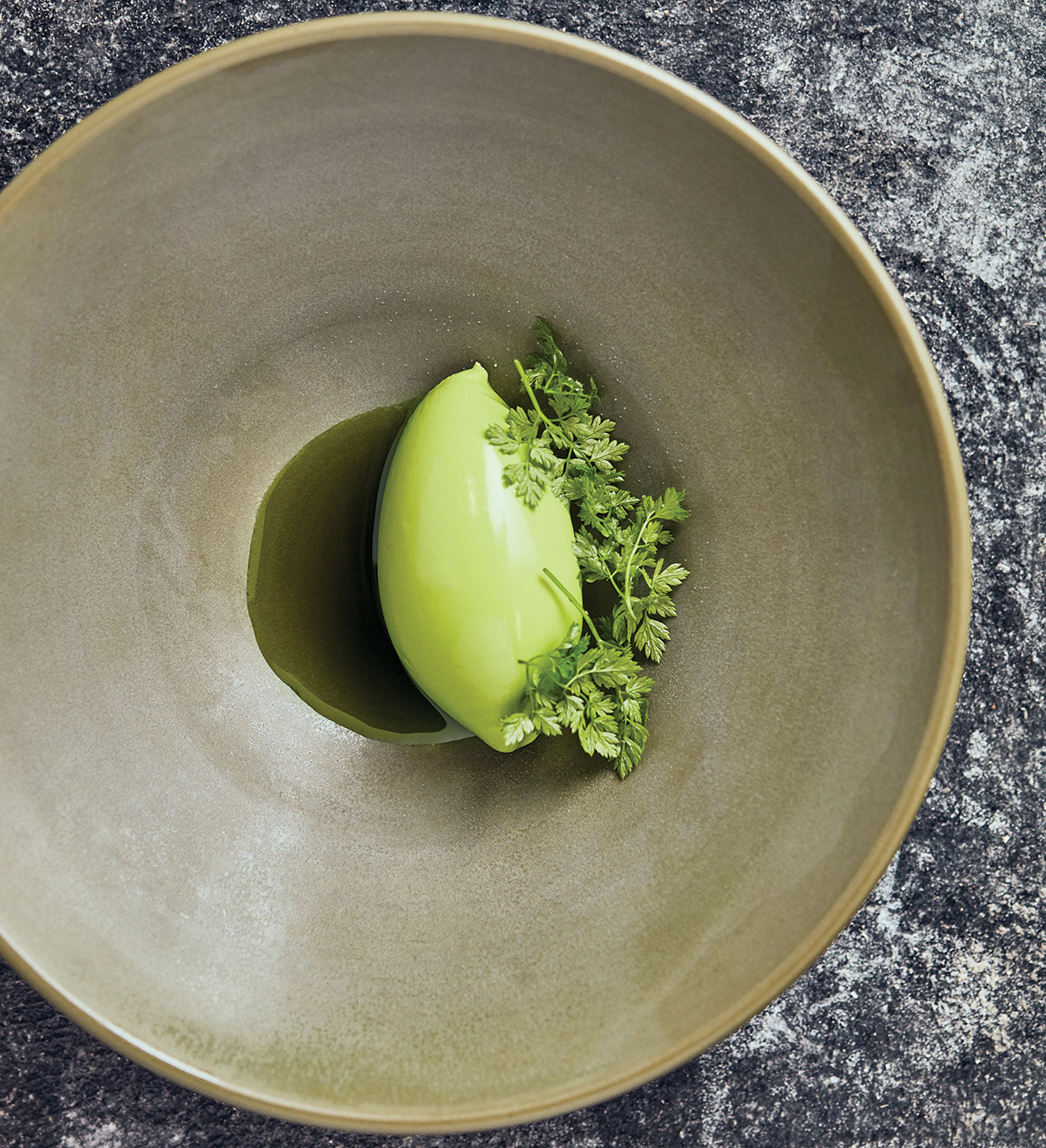
In early August of 2018, Ben Staley was preparing for evening dinner service at his restaurant, Alder Room, when he got the message he had been dreading: His investors were pulling the plug. After 15 months of operation, Alder Room was officially closed. With its companion bar, Alta, having sat empty for almost a year after just six months of operation — leaving Alder Room’s 12 seats responsible for covering rent for 4,500 sq ft on Jasper Avenue — Staley saw the writing on the wall.
Following its closure, Staley scrambled to mitigate the uncertainties: How would he reimburse a month’s worth of customers who had prepaid $160 each to reserve their seats? How would he survive having to declare personal bankruptcy? What would the public response be to this perceived failure?
But there was one thing he was certain of. Two days after Alder Room’s closure, Staley announced that he would be opening another restaurant, Yarrow. He couldn’t imagine doing anything else.
Staley’s personal and professional interests turned to the world of food at the age of 16 after making it to the finals in JOEY Restaurants’ first Top Apprentice Competition. “Finding something I was good at really gave me confidence,” Staley says. A year later, in 2009, some family friends introduced Staley to Darcy and Jessie Radies, the owners of The Blue Pear — a fine-dining restaurant that often featured a set five-course seasonal menu. They hired him as a cook, eventually promoting him to sous chef. “At the time it was the most progressive restaurant in the city and I learned a lot from Darcy,” Staley says. “He opened my eyes to what other restaurateurs were doing around the world.”
After The Blue Pear closed in 2012, a string of odd jobs led Staley to decide that he wanted to work for himself. But, at 22 years old with finances nowhere near close to being able to open a restaurant, it seemed unrealistic. Staley had no financial safety net; his parents raised four children while working multiple jobs and attending night classes.

Instead he applied for a chef’s position at an in-development restaurant. After meeting with and cooking for Kevin Cam and the other partners, he was offered the job and the opportunity to help develop the brand and the menu for what would become known as Cam’s first restaurant: North 53. “Kevin really took a chance on me,” Staley says. “I had no credentials whatsoever, but he gave me a lot of freedom.”
When North 53 opened in January 2014, it offered a set seasonal menu of six to eight dishes consisting entirely of Canadian-grown ingredients — no black pepper, no citrus, no chocolate. The concept was extremely different for Edmonton. In an interview for Avenue in 2015, Cam says the experimental food “bewildered diners” and that “people were intimidated by the concept,” but Staley says he was satisfied with the reception and figured there was still a market for his vision, albeit a niche one.
Staley left North 53 10 months later intent on opening his own restaurant — though he had nothing to make that happen. By November, Cam had completely overhauled the restaurant into a cocktail bar that served small plates, and in that same interview claimed it was a success with double revenue and triple volume. (North 53 closed in March 2018, at the end of the lease on the space, for Cam to focus on other projects downtown including Baijiu, Little Hong Kong, Royale and Pablo.)
While working out the concept for his second restaurant, Staley worked more odd jobs outside of the industry. His name had become synonymous with North 53 — perhaps because of the fascination with his youth — and, when word of his departure got around, the eyes of the Edmonton culinary scene were on him. One night at a pop-up dinner event, Staley was talking with guests at his table who asked about his new restaurant and, a few weeks later, asked Staley if they could invest. That gave Staley enough of an endorsement to find other partners, and they signed a lease in March 2016. The 4,500 sq. ft. space was meant to accommodate two concepts: Alta, a casual bar with snacks and drinks, and Alder Room, the evolution of his initial concept for North 53.

The tight ingredient restrictions of North 53 proved limiting, so Staley expanded to using regional ingredients. But the set menu stuck — it’s the one concept that Staley feels most passionate about. “I think best about food when I’m thinking about a menu as a whole, cohesive thing,” Staley says. “I like being able to guide the palate, to serve dishes that’ll work well together.”
Alder Room seated 12 and required reservations, and guests prepaid $160 each for a set menu of 15 to 20 “vegetable-forward” servings. This time, it would be impossible not to see Staley as synonymous with the
restaurant: With just a team of three staff, he pulled double duty as chef and server, and made interacting with the guests a fundamental part of their experiences. While he was certain about the concept, Staley was
still operating with limited restaurant experience. “I had no clue what I was doing,” Staley admits. “I just wanted to make it happen.” Perhaps unsurprisingly then, “everything went wrong.”
Two widespread and persistent negative reviews suggested that Alder Room would not be popular with customers, but Staley insists that the problems that plagued both spots were related to expenses and not customer feedback; the problems started with a five-month wait to get a building permit. Paying rent for a full year before Alta was able to open at the end of February 2017 put his team over budget, and Alder Room opened two months later with an unfinished room that Staley describes as “stark and austere.”
“By the time we opened, we were so far behind that we were never going to be able to succeed financially,” Staley says. “To this day, I love Alta. I’m very proud of it. But it was disjointed. It was supposed to be a casual wine bar, but a lot of people thought it was a fancy restaurant, and then there was this perception that we only served cold and raw food. I don’t know exactly how that was misconstrued, but that stuck with Alta and kept people away. We had a great team, the room was beautiful, and we had some extremely loyal customers but, at the end of the day, it just did not work.”

Keeping Alta open was too expensive, and it closed six months later to put the focus on Alder Room — but it also didn’t work to have a maximum of 12 nightly customers at Alder Room pay the rent for such a large combined space. Trying to fill the void that Alta left, Staley introduced a late-night service called “Random Snacks.” When more than 100 people showed up for snacks and drinks the first night, Staley made it a regular weekend offering. When Alder Room placed on enRoute magazine’s “Best New Restaurants in Canada” list in October 2017, it booked up months in advance with $100,000 worth of tickets sold in just three weeks.
It was still not enough. Less than two months after Alder Room shuttered, Yarrow moved from an idea to reality when two loyal customers of Alta and Alder Room offered to invest in Staley’s next project. (Staley says his partners wish to remain anonymous.) “They are very passionate about the concept, and I didn’t have to convince them about what I was trying to do,” Staley says. In a building behind Oliver Square, he got to work on renovating the space himself in order to save money on labour. Jordan Tomnuk of All Told studio and Tomnuk Design was hired to create custom light fixtures and ended up designing the entire space with green textured walls, rounded edges and soft lighting.
While Yarrow looks and feels very different from the minimalist Scandinavian design of Alder Room, the set menu of 18 to 22 servings persists. “It worked, people liked it,” Staley says. Staley and two other salaried staff pull multi-hyphenated duties as cooks, servers, hosts and bartenders, so the experience relies on a personal chef-to-guest interaction. Most of the cooking is done over open fire. “I like fire because it’s alive, it requires so much more attention, it requires you to put forward more skill, and it’s unforgiving,” Staley says. “It’s typically something that’s not associated with higher end restaurants, but I want to embrace the qualities of coal and fire to give food aroma and flavour, rather than just using it as a heat source.” Staley says the food on the frequently changing seasonal menus will be delicate, acidic and refreshing, and will incorporate seafood more than his menus have in the past. It will also include reimagined favourites from Alder Room (raw scallops in a buttermilk sauce) and new inventive pairings (raw sea urchin with squash puree).
Thanks to the success of Alder Room’s “Random Snacks” program, Yarrow also includes a small, casual bar that is accessible to everyone, not just those with dinner reservations. Alcohol is served alongside tinned seafood, candied nuts and some house-made, fun takes on familiar favourites like Ritz crackers and Oreo-type cookies. (If the tinned fish sounds odd, it’s a bar staple in Spain and Italy and increasingly popular in North America. We’re talking more than tuna.)
Staley thinks that, in this case, the third time’s a charm. “I’m hopelessly optimistic,” Staley says, and he’s certain that his restaurant experience concept is of interest. He’s certain that, while he loves cooking and entertaining, he does not want to work in a restaurant other than his own. With the ongoing learned experience that was missing pre-North 53, he’s confident that he can do it right this time.
With Yarrow as his third restaurant in six years following some very public criticisms, some might think the now-27-year-old Staley has been given too many chances — and he’s aware of that privilege. “Being a white male, I’m one of the most fortunate people on the planet,” Staley says without prompting. “I get that. I know that I have the ability to get opportunities more than other people. I’m grateful for everyone who’s ever taken a chance on me because they’re the reason why I’m here.”
At $170 a person, dinner at Yarrow will not be affordable for everyone. Staley is aware there’s some irony in that he probably can’t afford to eat at his own restaurant, but doesn’t think that’s the point. He insists the price is worth it for the amount and quality of food, and for the overall experience. “Some people can afford to go. It is inherently exclusive, but the experience isn’t stuffy or alienating. It’s casual and welcoming; we just have normal conversations.” Perhaps it’s worth keeping in mind what Pete Wells wrote about one of the world’s most popular restaurants, “the new Noma,” in 2018: “Isn’t $375 a lot of money? Yes. Noma is re-defining luxury, not abolishing it.” Isn’t $170 a lot of money? Sure, but Yarrow is trying to expand the local dining scene, not adhere to it. It’s also worth noting that, a little closer to home, Eight restaurant opened in Calgary in January 2020. It serves eight guests (you guessed it) eight courses of “meticulously sourced Canadian ingredients” every night for $185 per person.
There is, of course, a difference between concept and execution. Yarrow opened on January 3 and sold out its first two months of service. Diners are seemingly buying into the experience, and time will tell if they are satisfied with it. One of Yarrow’s first customers, Jeremy Bibaud, thinks that the restaurant feels “completely overhauled” from its predecessor. “I think where Alder Room felt more conceptual, Yarrow better balances the experimental cuisine with a more relaxed, intimate dining experience, and I think it’s mostly due to the environment and refreshing attitude Ben has towards his food and the people he’s serving.” With Staley present from coat check through the final course, Bibaud says the intimate experience feels “like a secret that you and nine other people stumbled onto.”
The food impressed Bibaud, too. “Every dish is unique and unlike anything I’ve tried elsewhere,” he says. “It’s clear you don’t come to Yarrow to try the chef’s take on a burger, you come to try something you’ve never had before. There’s a precision and thoughtfulness in the courses and a real sense that you’re tasting the final product of him riffing on an idea over and over until he had something he felt was special. One of the guests gave him an ovation after eating the sea urchin and, while that’s a bit over the top for me, I don’t blame him for being impressed.”
It’s not a coincidence that the name of the restaurant refers to a plant that, while delicate in appearance, is resilient and has the ability to grow in harsh conditions. After years of learning curves, the goal is, of course, for Yarrow’s restaurant and bar to find success in ways North 53 and Alder Room did not. “I want to be proud of it,” Staley says. “I want people to come and say, ‘Wow, this is something.’ I just want to make people happy. That’s a cook’s job.”









